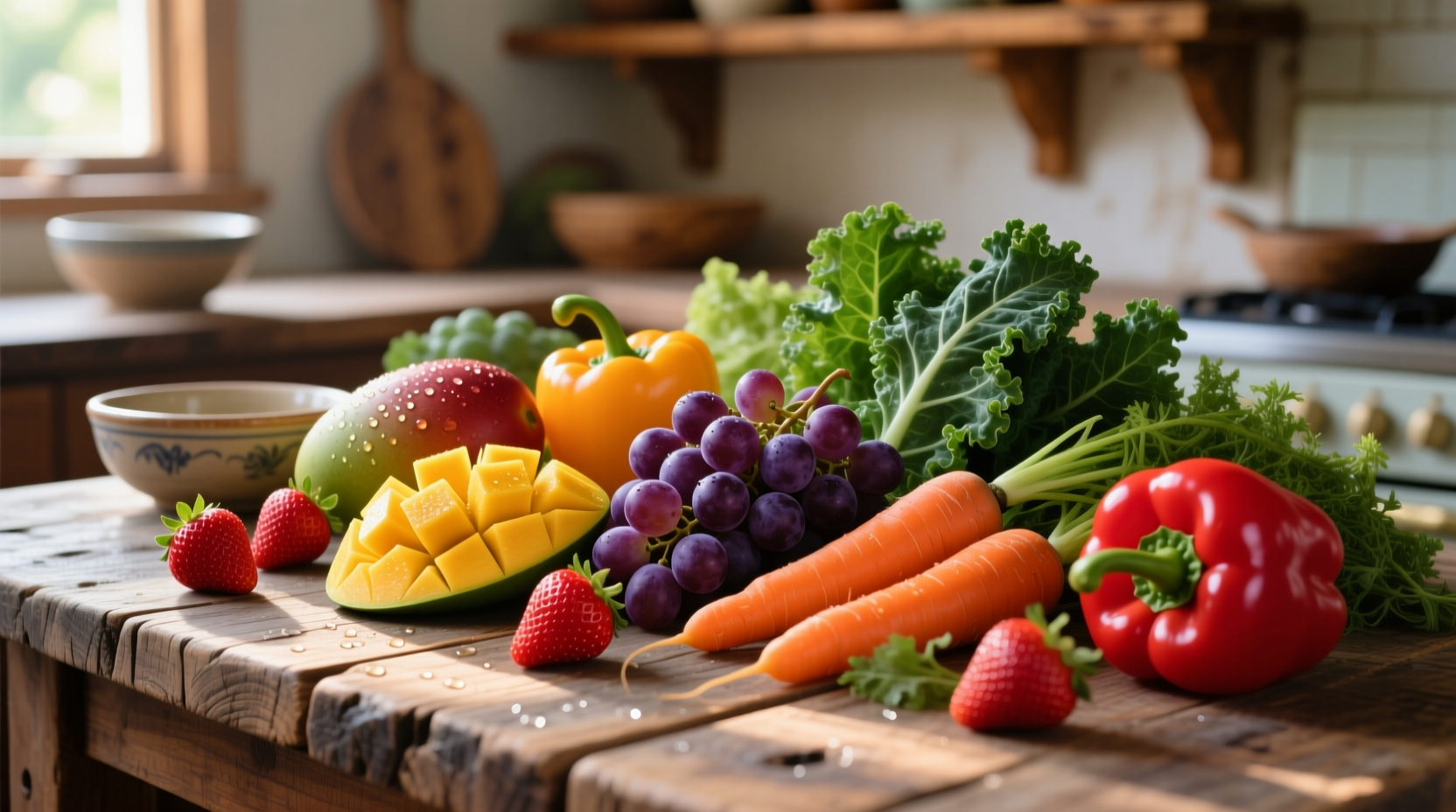Understanding Food Categories: Your Practical Guide
When searching for what kind of food best suits your needs, you're likely looking for clear guidance on food classification and selection. This guide breaks down food categories with practical insights you can apply immediately to your meal planning.
How Food Categories Work in Modern Nutrition
Modern nutrition science organizes food into five primary groups, each serving specific functions in maintaining health. Unlike historical approaches that focused solely on calories, today's framework emphasizes nutrient density and functional benefits. The USDA's MyPlate model provides the most widely accepted classification system used by health professionals worldwide.
| Food Group | Primary Nutrients | Daily Recommendation (Adults) | Top Health Benefits |
|---|---|---|---|
| Fruits | Vitamins C & A, fiber, antioxidants | 1.5-2 cups | Reduces chronic disease risk, supports immune function |
| Vegetables | Vitamins K & A, folate, fiber | 2-3 cups | Supports digestion, lowers blood pressure |
| Grains | B vitamins, iron, magnesium, fiber | 5-8 ounce-equivalents | Provides sustained energy, supports heart health |
| Protein Foods | Protein, iron, zinc, B vitamins | 5-6.5 ounce-equivalents | Builds muscle, supports metabolism, maintains tissue |
| Dairy | Calcium, vitamin D, protein | 3 cup-equivalents | Strengthens bones, supports nerve function |
According to the 2020-2025 Dietary Guidelines for Americans, proper distribution across these categories reduces risk of chronic diseases by 25-30% compared to imbalanced eating patterns. The guidelines emphasize variety within each group as crucial for comprehensive nutrient intake.
Choosing What Kind of Food Matches Your Specific Needs
Understanding what kind of food works best requires considering your individual circumstances. Different life stages and health conditions demand specific nutritional approaches:
Dietary Requirements by Life Stage
Children need higher proportions of dairy for bone development, while adults over 50 require more protein to combat age-related muscle loss. Pregnant women benefit from increased folate-rich foods like leafy greens and legumes. The National Institutes of Health provides detailed nutrient requirements based on age, sex, and life stage.
Managing Health Conditions Through Food Selection
For those asking what kind of food is good for digestion, fermented options like yogurt, kefir, and sauerkraut provide probiotics that improve gut health. Individuals managing diabetes should focus on non-starchy vegetables and whole grains with low glycemic indexes. The American Diabetes Association recommends filling half your plate with non-starchy vegetables for optimal blood sugar management.
Practical Food Selection Framework
When determining what kind of food to include in your meals, follow this decision-making process:
- Identify your primary goal (weight management, energy boost, disease prevention)
- Assess dietary restrictions (allergies, ethical choices, medical conditions)
- Evaluate cultural preferences that influence food acceptance
- Consider practical factors like budget, cooking time, and availability
- Build balanced combinations from multiple food groups

Context Matters: When Standard Guidelines Need Adjustment
While general food categories apply broadly, specific situations require nuanced approaches. Athletes need 20-30% more protein than sedentary individuals. Those following plant-based diets must strategically combine protein sources to ensure complete amino acid profiles. People with celiac disease must avoid gluten-containing grains entirely, requiring careful substitution planning.
The Academy of Nutrition and Dietetics emphasizes that what kind of food works best depends on individual biochemistry. Their research shows significant variation in how people metabolize identical foods, making personalized nutrition increasingly important.
Building Your Daily Food Pattern
For those wondering what kind of food should I eat for breakfast, focus on combinations that provide sustained energy. An ideal breakfast includes complex carbohydrates, protein, and healthy fats. Try Greek yogurt (protein) with berries (fruit) and chia seeds (healthy fats) for balanced morning nutrition.
When selecting what kind of food is high in protein for lunch or dinner, consider both animal and plant options. A 3-ounce serving of salmon provides 22 grams of complete protein, while 1 cup of cooked lentils offers 18 grams along with fiber and iron.
Avoiding Common Food Selection Mistakes
Many people make these errors when determining what kind of food to eat:
- Overemphasizing single food groups while neglecting others
- Choosing processed versions of healthy foods (like fruit juices instead of whole fruit)
- Following restrictive diets without professional guidance
- Ignoring portion sizes even with healthy foods
- Misunderstanding food labels and marketing claims
The Food and Drug Administration warns that "natural" claims on packaging don't guarantee nutritional value, and many products marketed as healthy contain added sugars or unhealthy fats.
Creating Sustainable Food Habits
Successful long-term eating patterns incorporate variety, flexibility, and enjoyment. Rather than asking what kind of food is healthy for weight loss as a temporary solution, focus on building habits you can maintain. Research from the National Center for Complementary and Integrative Health shows that sustainable dietary changes improve adherence by 65% compared to restrictive short-term approaches.
Putting It All Together: Your Food Selection Action Plan
Start implementing what you've learned about what kind of food today with these steps:
- Conduct a food group audit of your current eating patterns
- Identify one category where you need improvement
- Select two new foods from that category to try this week
- Create balanced meal templates for your most challenging eating occasion
- Track how different foods affect your energy and wellbeing
Remember that food preferences evolve over time. What works for you now might change with life circumstances, making regular reassessment essential for optimal nutrition.
Frequently Asked Questions
What kind of food is best for weight loss?
For sustainable weight loss, focus on whole, minimally processed foods across all categories with emphasis on vegetables, lean proteins, and whole grains. The most effective approach combines nutrient-dense foods with appropriate portion sizes. Research shows that diets rich in fiber from vegetables and whole grains increase satiety while reducing overall calorie intake.
What kind of food do vegetarians eat to get enough protein?
Vegetarians can meet protein needs through strategic combinations of plant-based foods. Excellent sources include legumes (lentils, chickpeas), soy products (tofu, tempeh), quinoa, nuts, seeds, and dairy/eggs for lacto-ovo vegetarians. Combining different plant proteins throughout the day ensures complete amino acid profiles. The Academy of Nutrition and Dietetics confirms well-planned vegetarian diets provide adequate protein for all life stages.
What kind of food is good for digestion?
Foods that support digestion include high-fiber options like vegetables, fruits, and whole grains, plus fermented foods containing probiotics such as yogurt, kefir, sauerkraut, and kimchi. The American Gastroenterological Association recommends gradually increasing fiber intake while drinking adequate water to prevent digestive discomfort. Ginger and peppermint also provide natural relief for occasional digestive issues.
What kind of food should I eat for breakfast to maintain energy?
An energy-sustaining breakfast combines complex carbohydrates, protein, and healthy fats. Examples include oatmeal with nuts and berries, whole-grain toast with avocado and egg, or Greek yogurt with chia seeds and fruit. The American College of Sports Medicine recommends including 20-30 grams of protein in your morning meal to stabilize blood sugar and maintain energy levels throughout the morning.
What kind of food is high in protein but low in fat?
Excellent high-protein, low-fat options include skinless poultry, fish (especially white fish), egg whites, legumes, and low-fat dairy products. A 3-ounce serving of cooked chicken breast provides about 26 grams of protein with only 3 grams of fat. For plant-based options, 1 cup of cooked lentils offers 18 grams of protein with minimal fat content. The Dietary Guidelines for Americans recommends these lean protein sources as part of a healthy eating pattern.











 浙公网安备
33010002000092号
浙公网安备
33010002000092号 浙B2-20120091-4
浙B2-20120091-4